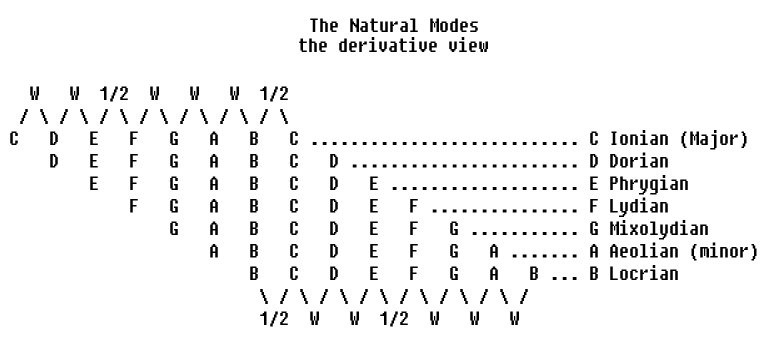This shows the relationship between the modes. I would call this the derivative, or relative view. In other words, all these different modes are derived from one set of notes. In other words, the are all related, and this, relative to this one group of notes. Here, the group of notes is the natural notes.
Practice improvising melodies along with these chord changes which establish each mode. In this way you can very naturally learn the notes which create tension and release both harmonically, and melodically.
Where To Go From Here
Next, try to see each mode as a chord scale. In this scenario, you would want to see how modes change along with chord changes. All sorts of modal interchange is possible. In order to get these once puts, the shortest path to take would be a parallel view.
Parallel Versus Derivative View
In parallel view, you would compare the modes for one tonic, or root note. This is where the number system comes in.
the Number System
The number system simply begins by numbering the so-called major scale. The major scale is the Ionian mode, so begin by numbering this.
Now, each interval is the equivalent of a number. A 1 is Unison. A 2 is a major second, or two frets…. As in a major scale. A 3 is a major third, as in a major scale. A 4 is a perfect fourth as in a major scales. 5 = perfect fifth. 6 = major sixth. 7 = major seventh. 8 = perfect octave. Etc.
Now, you can do a quick and useful comparison of the weight of each modal tone by learning the sound of degree/interval/number of the scales.
Number of Each Degree Equals. Oral Weight
You get the flat three, or minor third interval in the shortcut code of b3. Plus this implies the weight of this note, in the grand modal scheme by its relation to 3. The learner realizes that 3 = major = uplifting prosody wise. Conversely, the learner realizes that b3 = minor = dark, sad. The third of each scale, and tonality is indeed the 3rd, and it is major or minor dependent on whether this is a major or minor third. There is no shorter way to say this than 3 and b3.
The Chromatic Rainbow Slide-rule of the Tonal Palette
Follow these trains of thought to really master modes in a bigger sense, as colors to draw from and mix together to illicit optimal prosody in the music you create with your guitar. The chromatic rainbow slide rule of the tonal palette!
